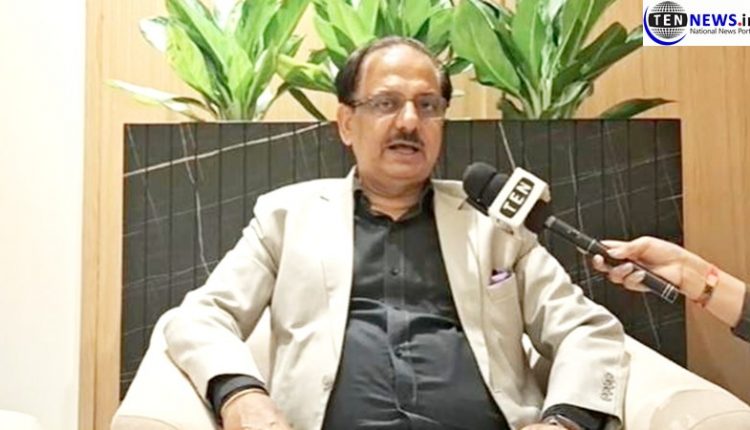Indian Handicrafts Sector Will Survive Tariff War – EPCH Chief Mentor Dr. Rakesh Kumar
TEN NEWS NETWORK
Greater Noida News (23 August 2025): Amid escalating trade tensions between the United States and India, Dr. Rakesh Kumar, Chief Mentor of the Export Promotion Council for Handicrafts (EPCH), has expressed confidence that the Indian handicrafts sector will withstand the impact of steep U.S. tariffs. In an exclusive interaction with Ten News Network, Dr. Rakesh Kumar shared his strategic perspective on how the industry can adapt and emerge stronger from this economic challenge.
Trump Slaps 50% Tariff on Indian Imports
On August 6, 2025, U.S. President Donald Trump signed a new executive order imposing an additional 25% tariff on imports from India. This comes on top of the 25% tariff announced just a week earlier on July 31, effectively doubling duties on Indian goods to 50%. The action, as per the executive order, is a direct response to India’s continued import of oil from Russia, which the Trump administration sees as undermining sanctions related to the ongoing Ukraine conflict.
The U.S. Department of Commerce clarified that the tariff hike is part of broader measures under Executive Order 14066, citing a “national emergency” and the need to penalize countries perceived as indirectly supporting the Russian economy through energy purchases.
India Calls Move “Extremely Unfortunate”
India’s Ministry of External Affairs has termed the decision “extremely unfortunate,” highlighting its potential to significantly impact bilateral trade, especially in sectors like handicrafts, textiles, and furniture—where India has traditionally been a strong exporter to the U.S. market.
Dr. Rakesh Kumar: “We Have Faced Bigger Crises—This Too Shall Pass”
Reacting to the tariff announcement, Dr. Rakesh Kumar said the development, while serious, was not entirely unexpected.
These kinds of abrupt and irrational tariff hikes are characteristic of the Trump administration. Similar actions have previously targeted China, the EU, and now India, Dr. Rakesh Kumar remarked. He pointed out that while the initial impact will be painful—especially since around 40% of India’s handicraft exports are destined for the U.S.—this does not spell doom for the sector.
This is certainly a setback. The U.S. is our biggest market, and these export volumes can’t be shifted overnight to another destination. But this is not the end of the road. Our industry has withstood crises before—be it the COVID-19 pandemic, global recessions, or geopolitical disruptions—and we’ve always found solutions, he asserted.
Diversification: A Key Lesson
Dr. Kumar emphasized that this situation offers a critical lesson for Indian exporters: the importance of market diversification.
We cannot afford to place all our eggs in one basket. Relying so heavily on one economy makes us vulnerable to geopolitical shifts. This is the right time to diversify our export destinations and build stronger trade relationships with other regions, he advised.
Time to Rethink Pricing, Channels, and Competition
Acknowledging the financial challenge posed by a 50% tariff, Dr. Kumar detailed a competitive analysis the EPCH conducted comparing Indian products with those from rival exporting countries such as Vietnam, Indonesia, Bangladesh, Pakistan, and Turkey.
Our products have become 20% to 35% more expensive due to the new tariffs. If an Indian product is priced at ₹100, the U.S. buyer will now pay ₹150 after tariffs, while a similar product from Vietnam or Turkey might cost far less. We must rethink our pricing models, he said.
One possible solution, he suggested, is to overhaul the distribution model. Currently, many Indian exporters go through multiple wholesale and distribution layers before reaching U.S. consumers. By cutting out intermediaries and directly targeting B2B buyers or boutique retailers, Indian exporters can reduce costs and partially absorb the impact of tariffs.
It won’t be easy, but it’s doable. We need a long-term strategy to reach consumers more directly, which would not only reduce distribution expenses but also increase our competitiveness in foreign markets, Dr. Rakesh Kumar noted.
Looking Ahead: Caution, Optimism, and Preparedness
Despite the grim short-term outlook, Dr. Rakesh Kumar struck a hopeful tone.
This crisis will not last forever. Even if the situation reverses in our favor, the lessons it teaches us—about diversification, resilience, and agility—must not be forgotten. We must prepare for a future where such shocks are part of global trade dynamics, he concluded.
As the tariff battle unfolds, the Indian government is expected to hold diplomatic talks with U.S. counterparts, while exporters begin recalibrating their strategies. One thing is clear—the Indian handicrafts sector is not bowing out without a fight. Stay connected with Ten News Network for more updates on international trade, policy changes, and their impact on Indian industry.
Dear Readers and Viewers, Please note that tennews.in: National News Portal daily publishes latest and top ten news from government, politics, national, business, education, technology, lifestyle, entertainment, health etc ten categories. You may submit your e mail and subscribe it to get updates on your e mail. Please also subscribe TEN NEWS NATIONAL YouTube Channel.



Comments are closed.